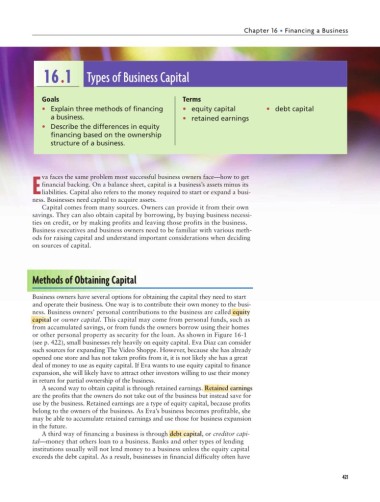Page 434 - Business Principles and Management
P. 434
Chapter 16 • Financing a Business
16.1 Types of Business Capital
Goals Terms
• Explain three methods of financing • equity capital • debt capital
a business. • retained earnings
• Describe the differences in equity
financing based on the ownership
structure of a business.
va faces the same problem most successful business owners face—how to get
financial backing. On a balance sheet, capital is a business’s assets minus its
Eliabilities. Capital also refers to the money required to start or expand a busi-
ness. Businesses need capital to acquire assets.
Capital comes from many sources. Owners can provide it from their own
savings. They can also obtain capital by borrowing, by buying business necessi-
ties on credit, or by making profits and leaving those profits in the business.
Business executives and business owners need to be familiar with various meth-
ods for raising capital and understand important considerations when deciding
on sources of capital.
Methods of Obtaining Capital
Business owners have several options for obtaining the capital they need to start
and operate their business. One way is to contribute their own money to the busi-
ness. Business owners’ personal contributions to the business are called equity
capital or owner capital. This capital may come from personal funds, such as
from accumulated savings, or from funds the owners borrow using their homes
or other personal property as security for the loan. As shown in Figure 16-1
(see p. 422), small businesses rely heavily on equity capital. Eva Diaz can consider
such sources for expanding The Video Shoppe. However, because she has already
opened one store and has not taken profits from it, it is not likely she has a great
deal of money to use as equity capital. If Eva wants to use equity capital to finance
expansion, she will likely have to attract other investors willing to use their money
in return for partial ownership of the business.
A second way to obtain capital is through retained earnings. Retained earnings
are the profits that the owners do not take out of the business but instead save for
use by the business. Retained earnings are a type of equity capital, because profits
belong to the owners of the business. As Eva’s business becomes profitable, she
may be able to accumulate retained earnings and use those for business expansion
in the future.
A third way of financing a business is through debt capital, or creditor capi-
tal—money that others loan to a business. Banks and other types of lending
institutions usually will not lend money to a business unless the equity capital
exceeds the debt capital. As a result, businesses in financial difficulty often have
421

